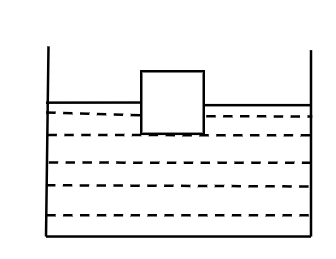
A plank is floating in a liquid as shown. Fraction \[f\] of its volume is immersed. Choose the correct options.

A. If the system is taken to a place where atmospheric pressure is more, '\[f\] ' will increase.
B. In the above condition \[f\] will remain unchanged.
C. If the temperature is increased and expansion of only liquid is considered \[f\] will increase.
D. If the temperature is increased and expansion of only plank is considered \[f\] will decrease.
Answer
218.7k+ views
Hint:The downforce generated by the object is equal to the upthrust. The force depends on many factors. By using the formula of equilibrium of a plank, we will find the relation between density and temperature.
Formula used
For equilibrium of the plank,
\[Vdg = (f_{V})\rho_{ L}g\]
Here, V is the volume of the plank.
d is the density of the plank
g is acceleration of gravity.
${f_V}$ is a buoyant force.
\[\rho_{ L}\] is the density of the liquid.
g is acceleration of gravity.
Complete step by step solution:
For equilibrium of the plank,
\[Vdg = (fV)\rho Lg\]
When the liquid expansion is taken into account, density drops as the temperature rises. Therefore, as \[l\] drops, \[f\] increases. Density \[d\] of plank falls when plank expansion is taken into account. Therefore, \[f\] declines.
Hence, if the temperature is increased and expansion of only liquid is considered \[f\] will increase, and if the temperature is increased and expansion of only plank is considered \[f\] will decrease.
Hence the correct options are C and D.
Additional information: A particle is considered to be in equilibrium when the net external force exerted on it is zero. We can state that the particle is either at rest or in uniform motion in this scenario by applying Newton's First Law of Motion.
Note: Students are often confused with the relation between density and temperature. If the temperature of a liquid increases then the density of the liquid decreases. If the temperature of a liquid decreases then the density of the liquid increases.
Formula used
For equilibrium of the plank,
\[Vdg = (f_{V})\rho_{ L}g\]
Here, V is the volume of the plank.
d is the density of the plank
g is acceleration of gravity.
${f_V}$ is a buoyant force.
\[\rho_{ L}\] is the density of the liquid.
g is acceleration of gravity.
Complete step by step solution:
For equilibrium of the plank,
\[Vdg = (fV)\rho Lg\]
When the liquid expansion is taken into account, density drops as the temperature rises. Therefore, as \[l\] drops, \[f\] increases. Density \[d\] of plank falls when plank expansion is taken into account. Therefore, \[f\] declines.
Hence, if the temperature is increased and expansion of only liquid is considered \[f\] will increase, and if the temperature is increased and expansion of only plank is considered \[f\] will decrease.
Hence the correct options are C and D.
Additional information: A particle is considered to be in equilibrium when the net external force exerted on it is zero. We can state that the particle is either at rest or in uniform motion in this scenario by applying Newton's First Law of Motion.
Note: Students are often confused with the relation between density and temperature. If the temperature of a liquid increases then the density of the liquid decreases. If the temperature of a liquid decreases then the density of the liquid increases.
Recently Updated Pages
Two discs which are rotating about their respective class 11 physics JEE_Main

A ladder rests against a frictionless vertical wall class 11 physics JEE_Main

Two simple pendulums of lengths 1 m and 16 m respectively class 11 physics JEE_Main

The slopes of isothermal and adiabatic curves are related class 11 physics JEE_Main

A trolly falling freely on an inclined plane as shown class 11 physics JEE_Main

The masses M1 and M2M2 M1 are released from rest Using class 11 physics JEE_Main

Trending doubts
JEE Main 2026: Application Form Open, Exam Dates, Syllabus, Eligibility & Question Papers

Derivation of Equation of Trajectory Explained for Students

Hybridisation in Chemistry – Concept, Types & Applications

Understanding the Angle of Deviation in a Prism

Understanding Collisions: Types and Examples for Students

Understanding Atomic Structure for Beginners

Other Pages
JEE Advanced Marks vs Ranks 2025: Understanding Category-wise Qualifying Marks and Previous Year Cut-offs

Units And Measurements Class 11 Physics Chapter 1 CBSE Notes - 2025-26

NCERT Solutions For Class 11 Physics Chapter 8 Mechanical Properties Of Solids

Motion in a Straight Line Class 11 Physics Chapter 2 CBSE Notes - 2025-26

NCERT Solutions for Class 11 Physics Chapter 7 Gravitation 2025-26

How to Convert a Galvanometer into an Ammeter or Voltmeter




